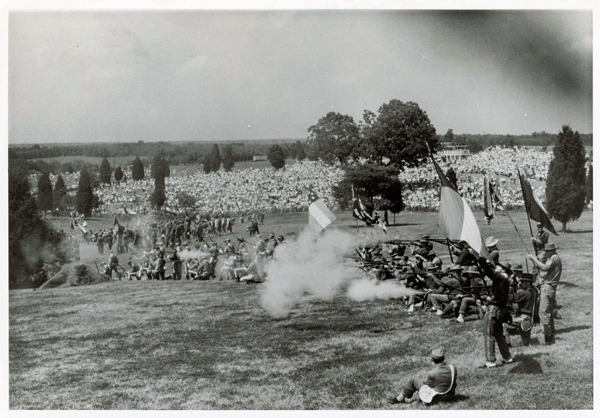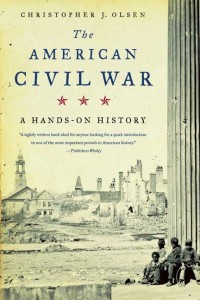dd
dd
dd
dd
By Christopher J. Olsen
In Spring 1861, both sides worked feverishly to train and equip the new armies, but the start of major hostilities would fall to the North. Confederate leaders believed that the onus was on the Union to invade and subdue the South, and they were content to let the war come to them. The army’s state of preparedness was not, however, the only factor determining when the Union attacked. Northerners were particularly restless, and newspaper editors urged Lincoln to order the troops south to “whip the Rebs” and end the folly of secession. In Washington, the commander of the Army of the Potomac—the Union force in northern Virginia—hesitated to send his raw recruits into battle. By July, though, Lincoln had heard enough from the press and insisted that his army advance toward Richmond. When General Irvin McDowell protested that his men needed more training, Lincoln responded, “[Y]ou are green, it is true, but they are green also. You are all green alike.” McDowell himself was untried in battle.
This initial Northern invasion and the resulting First Battle of Bull Run typified much about the Union’s efforts in the East during the first two years of the war. First, it was a good plan. McDowell intended to take his main force, about thirty-five thousand men ( a huge army, at that time the largest in American history), and attack the Confederated encamped at Manassas Junction, an important rail center just southwest of Washington. Confederate forces were divided between Manassas (twenty thousand) and the Shenandoah Valley (twelve thousand), a rich farming area about sixty miles west. General P.G.T. Beauregard commanded the main Southern force at Manassas. A skilled engineer and artilleryman, Beauregard came from an aristocratic French Creole family, had graduated from West Point, served in Mexico, and before secession ended his U.S. Army career, was named superintendent of West Point in 1861.

To keep the Confederates divided, the Union plan called for General Robert Patterson to make a feint with his smaller force in the Shenandoah Valley, holding the Southern troops there. The Union plan required timing and coordination; veteran soldiers might have pulled it off, but not the Northern army at this point. Instead, the timing was off—a second general characteristic of Union attacks—as troops got lost in the unfamiliar and heavily forested terrain, and their march was slower than expected. (Some men stopped to pick blackberries.) Patterson was fooled by a cavalry screen in the valley, allowing General Joseph E. Johnston to move his Confederate infantry (by rail) toward the main battle; consequently, when the two forces came together their strength was roughly even. Emblematic of the prevailing optimistic assumptions dozens of Northern civilians traveled after the army with opera glasses and picnic lunches of oysters and champagne, hoping to watch the first and last great battle of the Civil War.
On July 21, 1861, the Army of the Potomac met the Confederates in an open field just north of Manassas Junction and along the small creek of Bull Run. The day-long battle revealed the inexperience of men on both sides, and the Union lost the battle, in part because it failed to coordinate its attacks or exploit its numerical advantage—the third characteristic of Northern attacks. In the morning and early afternoon, McDowell’s men pushed the Confederates back toward Manassas, and seemed close to victory. But late in the afternoon, Beauregard and General Thomas J. Jackson rallied the Confederates and made a stand. According to legend, Southern general Bernard Bee, trying to inspire his own men, pointed to Jackson’s troops holding firm “like a stone wall” and told them to “rally behind the Virginians.” (The alternative story claims that Bee was actually criticizing Jackson for standing stupidly like a “stone wall” instead of retreating as he should have. ) As the Union advance was slowed by Jackson’s men, Johnston’s troops arrived in the nick of time and pushed straight into the battle. For the first time, the Confederates screamed wildly as they launched a furious counterattack: the “rebel yell” was born. The tide of the battle turned as thousands of Union troops retreated in total confusion. The soldiers became entangled with the civilians trying to escape the Confederates (two Northern congressmen were captured). The Southern press called it the “great skedaddle,” and the Union was humiliated. Senator Lyman Trumbull of Illinois termed it “the most shameful rout you can conceive of.”
The human cost of the battle staggered the nation. It was the deadliest in American history to that point, but only a small taste of the carnage yet to come. Nearly nine hundred men were killed at First Bull Run (almost as many died in battle during the entire Mexican War), another 2,600 were wounded. The Union defeat and miserable retreat to Washington gave the Confederacy a psychological edge for the next eighteen months. Among Union troops and officers in the East it created a sense of inferiority and doubt that was difficult to overcome. Southerners, of course, were jubilant; some predicted a quick negotiated peace.

Excerpted from The American Civil War: A Hands-on History by Christopher J. Olsen.
Copyright © 2006 by Christopher J. Olsen.
Reprinted with permission from Hill and Wang, an imprint of Farrar, Straus and Giroux, LLC.
CHRISTOPHER J. OLSEN is an assistant professor of history at Indiana State University and the author of The American Civil War: A Hands on History and Political Culture and Secession in Mississippi: Masculinity, Honor, and the Antiparty Tradition, 1830–1860.
